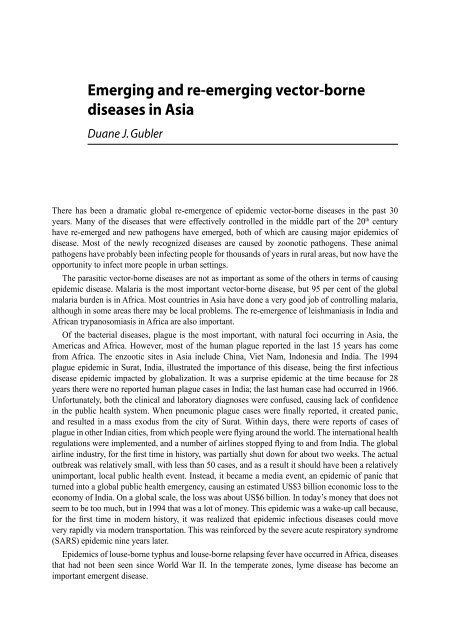South-East Asia Regional Conference on Epidemiology
South-East Asia Regional Conference on Epidemiology
South-East Asia Regional Conference on Epidemiology
You also want an ePaper? Increase the reach of your titles
YUMPU automatically turns print PDFs into web optimized ePapers that Google loves.
Emerging and re-emerging vector-borne<br />
diseases in <str<strong>on</strong>g>Asia</str<strong>on</strong>g><br />
Duane J. Gubler<br />
There has been a dramatic global re-emergence of epidemic vector-borne diseases in the past 30<br />
years. Many of the diseases that were effectively c<strong>on</strong>trolled in the middle part of the 20th century<br />
have re-emerged and new pathogens have emerged, both of which are causing major epidemics of<br />
disease. Most of the newly recognized diseases are caused by zo<strong>on</strong>otic pathogens. These animal<br />
pathogens have probably been infecting people for thousands of years in rural areas, but now have the<br />
opportunity to infect more people in urban settings.<br />
The parasitic vector-borne diseases are not as important as some of the others in terms of causing<br />
epidemic disease. Malaria is the most important vector-borne disease, but 95 per cent of the global<br />
malaria burden is in Africa. Most countries in <str<strong>on</strong>g>Asia</str<strong>on</strong>g> have d<strong>on</strong>e a very good job of c<strong>on</strong>trolling malaria,<br />
although in some areas there may be local problems. The re-emergence of leishmaniasis in India and<br />
African trypanosomiasis in Africa are also important.<br />
Of the bacterial diseases, plague is the most important, with natural foci occurring in <str<strong>on</strong>g>Asia</str<strong>on</strong>g>, the<br />
Americas and Africa. However, most of the human plague reported in the last 15 years has come<br />
from Africa. The enzootic sites in <str<strong>on</strong>g>Asia</str<strong>on</strong>g> include China, Viet Nam, Ind<strong>on</strong>esia and India. The 1994<br />
plague epidemic in Surat, India, illustrated the importance of this disease, being the first infectious<br />
disease epidemic impacted by globalizati<strong>on</strong>. It was a surprise epidemic at the time because for 28<br />
years there were no reported human plague cases in India; the last human case had occurred in 1966.<br />
Unfortunately, both the clinical and laboratory diagnoses were c<strong>on</strong>fused, causing lack of c<strong>on</strong>fidence<br />
in the public health system. When pneum<strong>on</strong>ic plague cases were finally reported, it created panic,<br />
and resulted in a mass exodus from the city of Surat. Within days, there were reports of cases of<br />
plague in other Indian cities, from which people were flying around the world. The internati<strong>on</strong>al health<br />
regulati<strong>on</strong>s were implemented, and a number of airlines stopped flying to and from India. The global<br />
airline industry, for the first time in history, was partially shut down for about two weeks. The actual<br />
outbreak was relatively small, with less than 50 cases, and as a result it should have been a relatively<br />
unimportant, local public health event. Instead, it became a media event, an epidemic of panic that<br />
turned into a global public health emergency, causing an estimated US$3 billi<strong>on</strong> ec<strong>on</strong>omic loss to the<br />
ec<strong>on</strong>omy of India. On a global scale, the loss was about US$6 billi<strong>on</strong>. In today’s m<strong>on</strong>ey that does not<br />
seem to be too much, but in 1994 that was a lot of m<strong>on</strong>ey. This epidemic was a wake-up call because,<br />
for the first time in modern history, it was realized that epidemic infectious diseases could move<br />
very rapidly via modern transportati<strong>on</strong>. This was reinforced by the severe acute respiratory syndrome<br />
(SARS) epidemic nine years later.<br />
Epidemics of louse-borne typhus and louse-borne relapsing fever have occurred in Africa, diseases<br />
that had not been seen since World War II. In the temperate z<strong>on</strong>es, lyme disease has become an<br />
important emergent disease.









